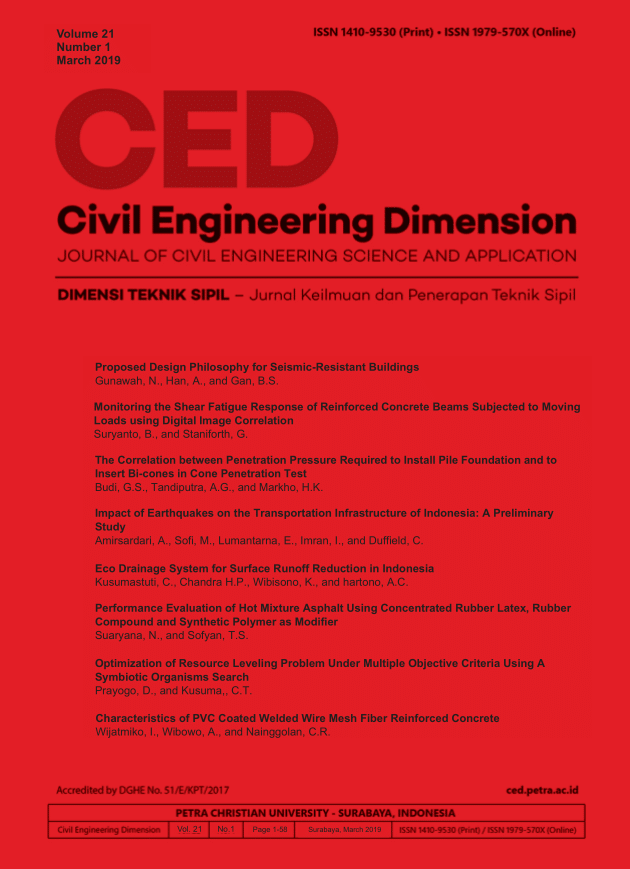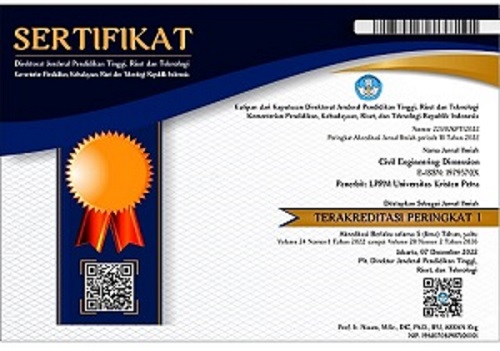Characteristics of PVC Coated Welded Wire Mesh Fiber Reinforced Concrete
 :
:
https://doi.org/10.9744/ced.21.1.50-56
Keywords:
Fiber, PVC coated wire mesh, concrete, tensile strength, compressive strengthAbstract
Introducing fibers into concrete aims to improve the low tensile strength of concrete and its brittle properties. In this research, readily available PVC coated welded wire mesh with diameter of 1 mm was used as fibers in concrete. There are several variations of concrete samples prepared for this study, i.e. based on the fiber’s volume fraction, length and interlocking schemes. Concrete samples were subjected to tensile and compressive strength, and elastic modulus tests. The results show that the incorporation of PVC coated welded wire mesh slightly increases the tensile strength of concrete, with the optimum fiber volume fraction of 1.5%; with the fiber length of 3.6 cm, and with the interlocking of 1.2 cm. However, the concrete compressive strength is slightly reduced, compared to the normal ones. The presence of PVC coated welded wire mesh as fiber also tends to reduce the elastic modulus of fiber reinforced concrete.References
Jacek, T. and Kozicki. J., Experimental and Theoretical Investigations of Steel-Fibrous Concrete. Gdansk (Polandia): Springer Science & Business Media. 2010.
Hasan, Y. and Sengul, O,,. Modulus of Elasticity of Substandard and Normal Concretes. Construction and Building Materials 25, pp.1645-1652. Turkey: Istanbul Technical University, Faculty of Civil Engineering. 2011
American Society of Testing Materials (ASTM) International C469. Standard Test Method for Static Modulus of Elasticity and Poisson’s Ratio of Concrete in Compression, United States. 1994.
Ismail, Z.,Z., and Al-Hashmi, E., Validation of Using Mixed Iron and Plastic Wastes in Concrete, Second International Conference on Sustainable Construction Materials and Technologies, 2011, ISBN 978-1-4507-1490-7.
Rambo, D. A. S.; De Andrade Silva, F.; Toledo Filho, R. D.: Effect of Steel Fiber Hybridization on the Fracture Behavior of Self-Consolidating Concretes, Cement and Concrete Composites 54, 2014, pp. 100–109. https://doi.org/10.1016/
Lee, J.-W.; Jang, Y.-I.; Park, W.-S.; Kim, S.-W. : A Study on Mechanical Properties of Porous Concrete using Cementless Binder, International Journal of Concrete Structures and Materials 10(4), 2016, pp. 527–537.
Thomas, J.; Ramaswamy, A. : Mechanical Properties of Steel Fiber-Reinforced Concrete, Journal of Materials in Civil Engineering 19(5), 2007, pp.385–392.
Sudheer Reddy, L; Ramana Rao, N.V.; Gunneswara Rao, T.D.: Shear Response of Fibrous High Strength Concrete Beams without Web Reinforcement, Civil Engineering Dimension, Vol.13, No.1, 2011, pp. 50-58.
Yazıcı, Ş.; Inan, G.; Tabak, V. : Effect of Aspect Ratio and Volume Fraction of Steel Fiber on the Mechanical Properties of SFRC, Construction and Building Materials 21(6), 2007, pp. 1250 – 1253.
Solis-Carcaño, R.; Moreno, E. I. : Evaluation of Concrete Made with Crushed Limestone Aggregate Based on Ultrasonic Pulse Velocity, Construction and Building Materials 22(6), 2008, pp. 1225–1231.
Sukontasukkul, P. : Use of Crumb Rubber to Improve Thermal and Sound Properties of Pre-Cast Concrete Panel, Construction and Building Materials 23(2), 2009, pp.1084–1092.
Wijatmiko, I., Wibowo, A., Nainggolan, C.R., 2017, The Effect of Polymer Coated Pumice to the Stiffness and Flexural Strength of Reinforce Concrete Beam. MATEC Web Conf., SICEST 2016.
Downloads
Published
How to Cite
Issue
Section
License
Authors who publish with this journal agree to the following terms:- Authors retain the copyright and publishing right, and grant the journal right of first publication with the work simultaneously licensed under a Creative Commons Attribution License that allows others to share the work with an acknowledgement of the work's authorship and initial publication in this journal.
- Authors are able to enter into separate, additional contractual arrangements for the non-exclusive distribution of the journal's published version of the work (e.g., post it to an institutional repository or publish it in a book), with an acknowledgement of its initial publication in this journal.
- Authors are permitted and encouraged to post their work online (e.g., in institutional repositories or on their website) followingthe publication of the article, as it can lead to productive exchanges, as well as earlier and greater citation of published work (See The Effect of Open Access).

















